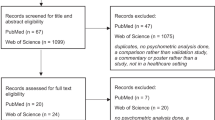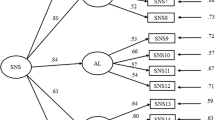Abstract
In this paper, we reviewed the available instruments for assessing the negative syndrome of schizophrenia, describing their strengths and weaknesses. Current instruments were classified into two categories according to their content validity and assessment approach as first- or second-generation instruments. The BPRS, SANS, the SENS and the PANSS belong to the first generation, while the BNSS, the CAINS and the MAP-SR belong to the second generation. The NSA can be considered a transitional instrument between the two. First-generation instruments have more content validity problems than second-generation instruments do, as they do not accurately reflect the currently accepted negative syndrome (they do not include all negative symptoms and signs or they include symptoms from other dimensions). They also have more problems relative to the use of behavioural referents instead of internal experiences of deficits when assessing symptoms, which may lead to measuring functioning instead of negative symptoms. Further research needs to be done in this area in order to ensure the evaluation of primary negative symptoms and internal experiences involved in negative symptoms rather than external behaviours.

Similar content being viewed by others
References
Kirkpatrick B, Fenton W, Carpenter WT, Marder ST (2006) The NIMH–MATRICS consensus statement on negative symptoms. Schizophr Bull 32:296–303
Kring AM, Gur RE, Blanchard JJ, Horan WP, Reise SP (2013) The clinical assessment interview for negative symptoms (CAINS): final development and validation. Am J Psychiatry 170:165–172
Kirkpatrick B, Strauss GP, Nguyen L, Fischer BF, Daniel D, Cienfuegos A, Marder SR (2011) The brief negative symptom scale: psychometric properties. Schizophr Bull 37:300–305
Marder SP, Kirkpatrick B (2014) Defining and measuring negative symptoms of schizophrenia in clinical trials. Eur Neuropsychopharmacol 24:737–743
Garcia-Portilla MP, Bobes J (2013) The new challenge in identifying the negative syndrome in schizophrenia. Rev Psiquiatr Salud Ment (Barc.) 6:141–143
Overall JE, Gorham DR (1962) The brief psychiatric rating scale. Psychol Rep 10:790–812
Andreasen NC (1983) Scale for the assessment of negative symptoms. University of Iowa, Iowa City
Selten JP, Sijben AES, van den Bosch RJ, Omloo-Visser H, Warmerdam H (1993) The subjective experience of negative symptoms: a self-rating scale. Compr Psychiatry 34:192–197
Kay SR, Fiszbein A, Opler LA (1987) The positive and negative syndrome scale (PANSS) for schizophrenia. Schizophr Bull 13:261–271
Llerena K, Park SG, McCarthy JM, Couture SM, Bennett ME, Blanchard JJ (2013) The motivation and pleasure scale-self-report (MAP-SR): reliability and validity of a self-report measure of negative symptoms. Compr Psychiatry 54:568–574
Alphs LD, Summerfelt A, Lann H, Muller RJ (1989) The negative symptom assessment: a new instrument to assess negative symptoms of schizophrenia. Psychopharmacol Bull 25:159–163
Overall JE, Gorham DR (1976) The Brief Psychiatric Rating Scale, ECDEU Assessment Manual Psychopharmacology, Guy W, ed. Rockville, MD: US Department of Health Education and Welfare
Lukoff D, Liberman RP, Nuechterlein KH (1986) Symptom monitoring in the rehabilitation of schizophrenic patients. Schizophr Bull 12:578–602
Dingemans AJ, Linszen DH, Lenior ME, Smeets RM (1995) Component structure of the brief psychiatric rating scale (BPRS-E). Psychopharmacology 122:263–267
Mueser KT, Curran PJ, McHugo GJ (1997) Factor structure of the brief psychiatric rating scale in schizophrenia. Psychol Assess 9:196–204
Ruggeri M, Koeter M, Schene A, Bonetto C, Vazque-Barquero JL, Becker T, Knapp M, Knudsen HC, Tansella M, Thornicroft G, the EPSILON Study Group (2005) Factor solution of the BPRS-expanded version in schizophrenic outpatients living in five European countries. Schizophr Res 75:107–117
Kopelowicz A, Ventura J, Liberman RP, Mintz J (2008) Consistency of brief psychiatric rating scale factor structure across a broad spectrum of schizophrenia patients. Psychopathology 41:77–84
Burlingame GM, Seaman S, Johnson JE, Whipple J, Richardson E (2006) Sensitivity to change of the brief psychiatric rating scale-extended (BPRS-E): an item and subscale analysis. Psychol Serv 3:77–87
Peralta V, Cuesta MJ (1995) Negative symptoms in schizophrenia: a confirmatory factor analysis of competing models. Am J Psychiatry 152:1450–1457
Peralta V, Cuesta MJ, de Leon J (1995) Positive and negative symptoms/syndromes in schizophrenia: reliability and validity of different diagnostic systems. Psychol Med 25:43–50
Levine SZ, Leucht S (2013) Psychometric analysis in support of shortening the scale for the assessment of negative symptoms. Eur Neuropsychopharmacol 23:1051–1056
Levine SZ, Leucht S (2013) Identifying clinically meaningful symptom response cut-off values on the SANS in predominant negative symptoms. Schizophr Res 145:125–127
Selten JP, Wiersma D, van den Bosch RJ (2000) Discrepancy between subjective and objective ratings for negative symptoms. J Psychiatr Res 34:11–13
Marder SR, Davis JM, Chouinard G (1997) The effects of risperidone on the five dimensions of schizophrenia derived by factor analysis: combined results of the North American trials. J Clin Psychiatry 58:538–546
Obermeier M, Schennach-Wolff R, Meyer S, Möller HJ, Riedel M, Krause D, Seemüller F (2011) Is the PANSS used correctly? A systematic review. BMC Psychiatry 11:113
Marder SR, Daniel DG, Alphs L, Awad AG, Keefe RS (2011) Methodological issues in negative symptom trials. Schizophr Bull 37:250–254
Daniel DG, Alphs L, Cazorla P, Bartko JJ, Panagides J (2011) Training for assessment of negative symptoms of schizophrenia across languages and cultures: comparison of the NSA-16 with the PANSS negative subscale and negative factor symptom. Clin Schizophr Rel Psychoses 5:87–94
Khan A, Lindenmayer JP, Opler M, Yavorsky C, Rothman B, Lucic L (2013) A new integrated negative symptom structure of the positive and negative syndrome scale (PANSS) in schizophrenia using item response analysis. Schizophr Res 150:185–196
Khan A, Lewis C, Lindenmayer JP (2011) Use of non-parametric item response theory to develop a shortened version of the positive and negative syndrome scale (PANSS). BMC Psychiatry 11:178
van Erp TG, Preda A, Nguyen D, Faziola L, Turner J, Bustillo J, Belger A, Lim KO, McEwen S, Voyvodic J, Mathalon DH, Ford J, Potkin SG, FBIRN (2014) Converting positive and negative symptom scores between PANSS and SAPS/SANS. Schizophr Res 152:289–294
Axerold BN, Goldman RS, Alphs LD (1993) Validation of the 16-item negative symptom assessment. J Psychiatr Res 27:253–258
Alphs L, Morlock R, Coon C, van Willigenburg A, Panagides J (2010) The 4-item negative symptom assessment (NSA-4) instrument: a simple tool for evaluating negative symptoms in schizophrenia following brief training. Psychiatry (Edgemont) 7:26–32
Strauss GP, Hong LE, Gold JM, Buchan RW, McMahon RP, Keller WR, Fischer BA, Catalano LT, Culbreth AJ, Carpenter WT, Kirkpatrick B (2012) Factor structure of the brief negative symptom scale. Schizophr Res 142:96–98
Gard DE, Kring AM, Gard MG, Horan WP, Green MF (2007) Anhedonia in schizophrenia: distinction between anticipatory and consummatory pleasure. Schizophr Res 93:253–260
Strauss GP, Keller WR, Buchanan RW, Gold JM, Fischer BA, McMahon RP, Catalano LT, Culbreth AJ, Carpenter WT, Kirkpatrick B (2012) Next-generation negative symptom assessment for clinical trials: validation of the brief negative symptom scale. Schizophr Res 142:88–92
Kirkpatrick B, Galderisi S (2008) Deficit schizophrenia: an update. World Psychiatry 7:143–147
Garcia-Portilla MP, Garcia-Alvarez L, Mané A, Garcia-Rizo C, Sugranyes G, Bergé D, Bernardo M, Fernández-Egea E, Bobes J (2015) The negative syndrome of schizophrenia: Three- better than two-underlying components. Schizophr Res (in press)
Forbes C, Blanchard JJ, Bennett M, Horan WP, Kring A, Gur R (2010) Initial development and preliminary validation of a new negative symptom measure: the clinical assessment interview for negative symptoms (CAINS). Schizophr Res 124:36–42
Horan WP, Kring AM, Gur RE, Reise SP, Blanchard JJ (2011) Development and psychometric validation of the clinical assessment interview for negative symptoms (CAINS). Schizophr Res 132:140–145
Blanchard JJ, Kring AM, Horan WP, Gur RE (2011) Toward the next-generation of negative symptom assessments: the collaboration to advance negative symptom assessment in schizophrenia. Schizophr Bull 37:291–299
Barch DM (2013) The CAINS: theoretical and practical advances in the assessment of negative symptoms in schizophrenia. Am J Psychiatry 170:133–135
Park SG, Llerena K, McCarthy JM, Couture SM, Bennett ME, Blanchard JJ (2012) Screening for negative symptoms: preliminary results from the self-report version of the Clinical Assessment Interview for Negative Symptoms. Schizophr Res 135:139–143
Acknowledgments
We thank Sharon Grevet for her English assistance.
Conflict of interest
The authors have no conflicts of interests with the article’s content to declare.
Ethical standard
The manuscript does not contain clinical studies or patient data.
Author information
Authors and Affiliations
Corresponding author
Rights and permissions
About this article
Cite this article
Garcia-Portilla, M.P., Garcia-Alvarez, L., Saiz, P.A. et al. Psychometric evaluation of the negative syndrome of schizophrenia. Eur Arch Psychiatry Clin Neurosci 265, 559–566 (2015). https://doi.org/10.1007/s00406-015-0595-z
Received:
Accepted:
Published:
Issue Date:
DOI: https://doi.org/10.1007/s00406-015-0595-z




